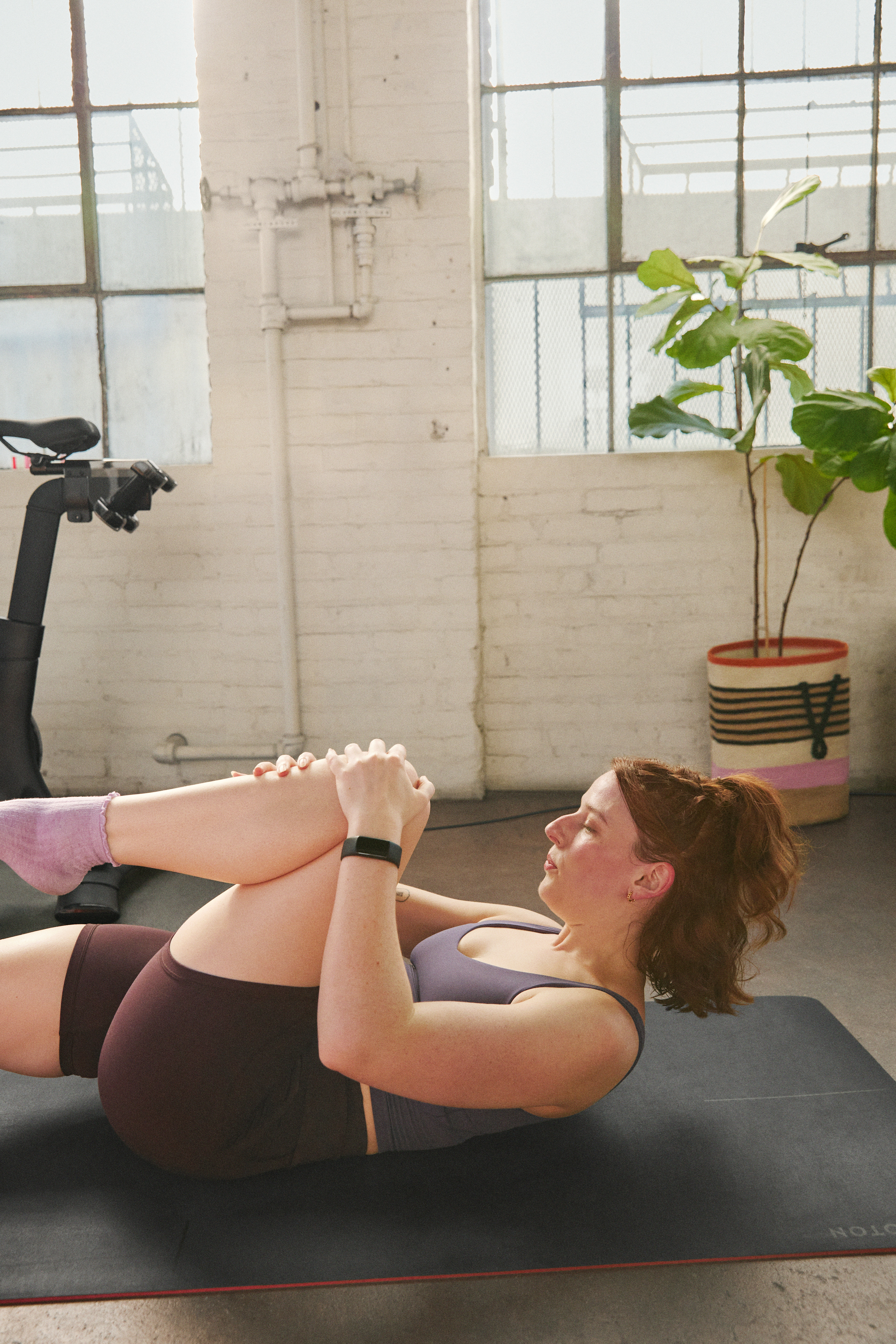
Does Pilates Count As Cardio? Here’s What Experts Have to Say
Whether or not Pilates counts towards your cardio goals, the practice comes with tons of perks.
By Danielle Zickl•
Is Pilates Cardio?
Mat vs. Equipment-Based Pilates: Which Works Your Heart More?
The Overall Benefits of Pilates
How to Use Pilates to Complement Your Cardio Workouts
The Takeaway
As Pilates continues to skyrocket in popularity, you may be wondering exactly what type of workout you’d be adding to your routine if you try it out. You might feel your muscles burning as you go through moves like the hundred, plank, and roll up, and assume it counts as strength training (it does!).
Discover more ways to reach your goals with Peloton
You may also begin to breathe heavily as your class goes on, but don’t feel anywhere near as winded as you do on the days you go for a run or take an indoor cycling class. So, is Pilates cardio? We talked to experts to find out.
Is Pilates Cardio?
Generally speaking, the answer is no. While it depends on the type of Pilates you’re doing and at what intensity, Pilates isn’t inherently a cardio workout, says Peloton instructor Mila Lazar. “Pilates is a mind-body discipline that emphasizes neuromuscular control, core strength, and alignment through precise, low-impact movements,” she explains.
Indeed, physical therapist and certified Pilates instructor Anabelen Aranton confirms that Pilates is typically more of a strength-based workout. “You’re using your own body weight to build muscle, though you can use light weights—like ankle weights or dumbbells—to add more resistance,” she says, and the same applies if you practice Pilates on an apparatus like a reformer. In fact, a small 2015 study published in Age found that following a 12-week Pilates training program was effective in improving upper-body, lower-body, and abdominal strength.
With that being said, if you’re doing intermediate or advanced Pilates in a flowing sequence with minimal rest, or using a jumpboard on the reformer, it may send you creeping into a higher heart rate zone, Mila explains. “These styles engage both the muscular system and respiratory system in a way that challenges endurance and elevates the heart rate, though not typically to the level of traditional cardio modalities like running or cycling,” she says.

Peloton App
Access thousands of classes with no equipment needed.
Aranton agrees, adding that if you do Pilates movements at a faster pace, your heart rate can start climbing into zone 2, which is equivalent to about 60 to 70 percent of your max heart rate, and is considered low- to moderate-intensity cardio.
“Cardio is any activity that increases your heart rate and demands more effort from your lungs compared to when you’re at rest,” Aranton says. For the workout to truly count as cardio, though, keep in mind that you’ll need to get up into that heart-rate range (or higher) and maintain it over time. (If you’re not wearing a heart rate monitor, you can go by rate of perceived exertion, or RPE, which is based on how hard you feel you’re working. For an activity to be considered cardio, you want to be working at an RPE of at least a 2 out of 10 or at least an 8 on the Borg RPE scale of 6–20.)
It’s important to note that everyone is different, so an activity that gets one person’s heart rate up to that extent may not get another person’s heart rate to the same level, Aranton explains. It depends on factors like age, fitness level, health conditions, and other factors. Translation: What registers as a cardio activity for you might not for your Pilates class BFF.
Mat vs. Equipment-Based Pilates: Which Works Your Heart More?
Both mat and equipment-based Pilates (e.g., on a reformer) work your heart in a similar way, depending on the types of exercises you’re doing and how short the breaks are in between, Mila explains.
“Mat Pilates classes can provide more of a cardiovascular challenge than people anticipate, especially when the class is continuous and includes compound bodyweight movements that activate large muscle groups, such as the glutes, quadriceps, hamstrings, and deep core muscles,” Mila says.
And on the reformer, the potential for cardiovascular work increases with the jumpboard or circuit-style programming, Mila says. During these sessions, you’ll usually work through dynamic resistance-based movement patterns that can elevate your heart rate by engaging your posterior chain, lower body, and power-generating muscles in a more plyometric (read: explosive) way, she says.
“While both formats can offer cardio benefits under the right structure, reformer Pilates has more tools to scale intensity safely and systematically,” Mila says.

FG Trade via Getty Images
The Overall Benefits of Pilates
Thinking of adding Pilates to your weekly workout routine? Good news: Even if it doesn’t help you check cardio off your to-do list, this modality comes with a ton of other perks, according to both Mila and Aranton.
1. It Builds Functional Strength
Functional strength refers to the muscle and power needed to make daily activities—like carrying your groceries into your house, lifting heavy moving boxes, or picking up your pets or kids—easier. Pilates helps build functional strength, according to Mila, because it targets all the muscles in your body, especially your core, which helps your upper and lower body generate power.
“Pilates exercises activate our deep abdominal muscles—transversus abdominis, internal obliques, pelvic floor—and it enhances trunk control and spinal integrity,” Mila says.
2. It Enhances Balance and Coordination
Another major benefit of Pilates is that it can help improve your balance. For instance, a small 2022 study in the Journal of Bodywork and Movement Therapies found that older adults who did six weeks of Pilates had better balance than they did at the start, helping to reduce the risk of falls. These findings are in line with those of a 2020 review in Complementary Therapies in Medicine.
Additionally, Pilates is great for body awareness and, therefore, coordination. “It enhances kinesthetic sense, leading to more controlled and intentional movement across all types of training,” Mia says. Indeed, doing Pilates once a week for 10 weeks improved body awareness in young sedentary women, according to a 2016 study in Physiology & Behavior, while a 2021 review in Frontiers in Neurology also concluded that Pilates helps boost coordination and balance.
3. It Improves Posture
Pilates is beneficial for your posture, according to both Mila and Aranton. This is because it strengthens the muscles of your spine and core, all of which help you sit and stand up straight.
For example, a 2010 study in Clinical Biomechanics found that two hours of Pilates per week for 12 weeks was found to be effective in improving upper spine posture as well as stabilizing core posture. A 2024 review in the Archives of Rehabilitation Research and Clinical Translation also found that Pilates can improve postural problems like spinal deformities, forward head posture, pelvic tilt, and thoracic kyphosis (where your spine curves outward more than it should).
4. It Boosts Mobility and Flexibility
“Pilates helps with joint mobility and flexibility,” Mila says. “It improves range of motion in key joints, including the hips, thoracic spine, and shoulders, promoting more efficient movement patterns.” FYI: Mobility refers to the ability to move freely through your full range of motion, while flexibility refers to the ability to stretch.
Plenty of research backs this up. For instance, a small 2010 study in the Journal of Strength and Conditioning Research found that doing two hours of Pilates per week for 12 weeks could improve hamstring flexibility, while a small 2022 study in the Journal of Bodywork and Movement Therapies found that doing Pilates for two hours a week for six weeks was enough to see mobility improvements.
5. It Helps with Breath Control
“A great benefit [of Pilates] is breath control, especially for those who run,” Mila says. “Pilates trains the diaphragm and integrates breath with movement to optimize intra-abdominal pressure, endurance, and mental focus.”
According to a 2018 study in PLOS One, runners who did Pilates twice a week for 12 weeks had faster 5K finish times than those who didn’t. Among the moves the runners performed were Pilates breathing exercises like the hundred.
Try a Pilates Class on the Peloton App
How to Use Pilates to Complement Your Cardio Workouts
For disease prevention and overall wellbeing, the World Health Organization (WHO) recommends that adults aim for at least 150 minutes of moderate-intensity aerobic exercise, 75 minutes of vigorous-intensity exercise, or an equivalent mix of the two per week. So if Pilates is your only source of physical activity, you’re likely not getting your heart pumping enough.
Luckily, Pilates and cardio workouts go hand-in-hand. “Pilates is a strategic complement to cardio training because it supports movement efficiency, recovery, and performance,” Mila says—all of which support your cardio efforts. Specifically, Pilates does the following, she explains:
It prevents injuries by strengthening the stabilizer muscles around key joints (like your gluteus medius, rotator cuff, and scapular stabilizers), therefore reducing injury risk from the repetitive motions often involved in cardio exercises like running, cycling, and rowing.
It improves your mechanics by promoting correct alignment and potentially helping to reduce gait inefficiencies, which is especially relevant for runners and cyclists.
It increases circulation and promotes muscle lengthening without high impact or fatigue, which can aid in accelerating recovery post-cardio.
Mila recommends doing Pilates two to three times per week in conjunction with your favorite cardio activities, like running or cycling, focusing on Pilates sessions that emphasize mobility and breathwork, core stability, and strength integration.
To fit it all in, you can definitely do cardio and Pilates on the same day, Aranton says. For instance, you can go for a walk before your Pilates session so your muscles are warmed up and ready to go, or you can do the opposite and perform Pilates moves like hip bridges and leg circles as a precursor to a run, as a way to activate those muscles before logging your miles.
The Takeaway
While Pilates counts more toward your strength goals than your cardio goals, there are certain variations that can tap more into your cardiovascular heart rate zones, like reformer Pilates or power Pilates, the latter of which you’ll find on the Peloton App (just look for the 30-Minute Pilates: Power classes).
If you’re on the hunt for activities that will count towards your cardio quota, turn to other workout options (such as walking, running, cycling, dance cardio, or swimming), which you can—and should—include in your routine alongside Pilates. Remember: A mix of strength and cardio is key for your overall health and wellbeing.
This content is for informational and educational purposes only and does not constitute individualized advice. It is not intended to replace professional medical evaluation, diagnosis, or treatment. Seek the advice of your physician for questions you may have regarding your health or a medical condition. If you are having a medical emergency, call your physician or 911 immediately.
Build full-body strength
Enter your email to get articles, instructor tips, and updates from Peloton sent to your inbox.
By providing your email address, you agree to receive marketing communications from Peloton.
For more about how we use your information, see our Privacy Policy.













